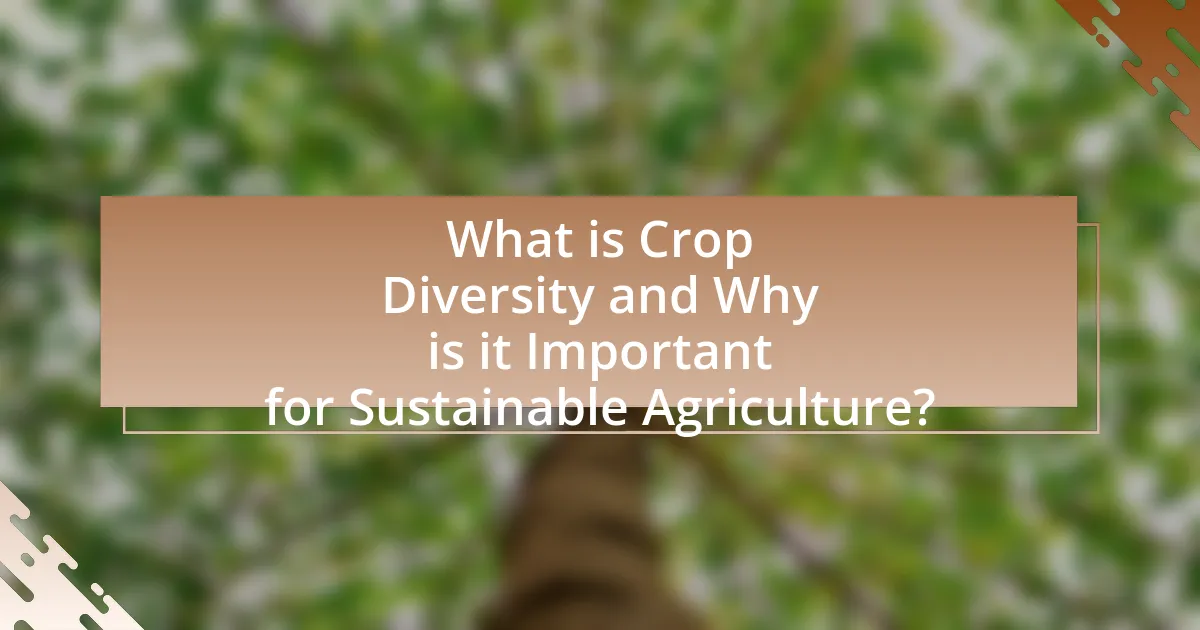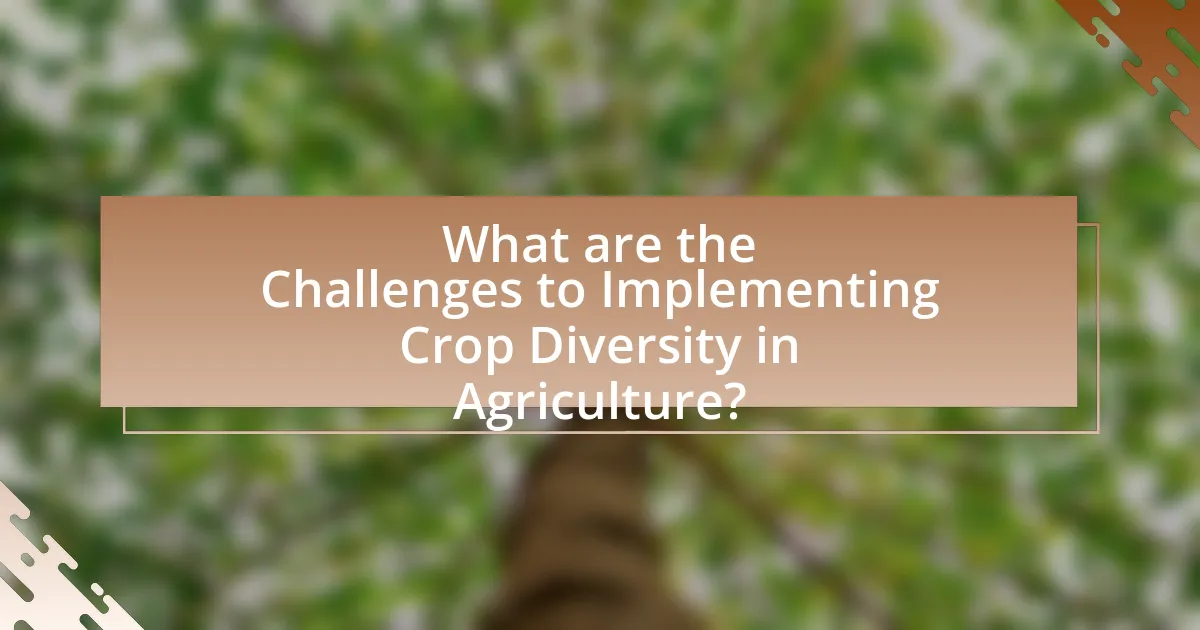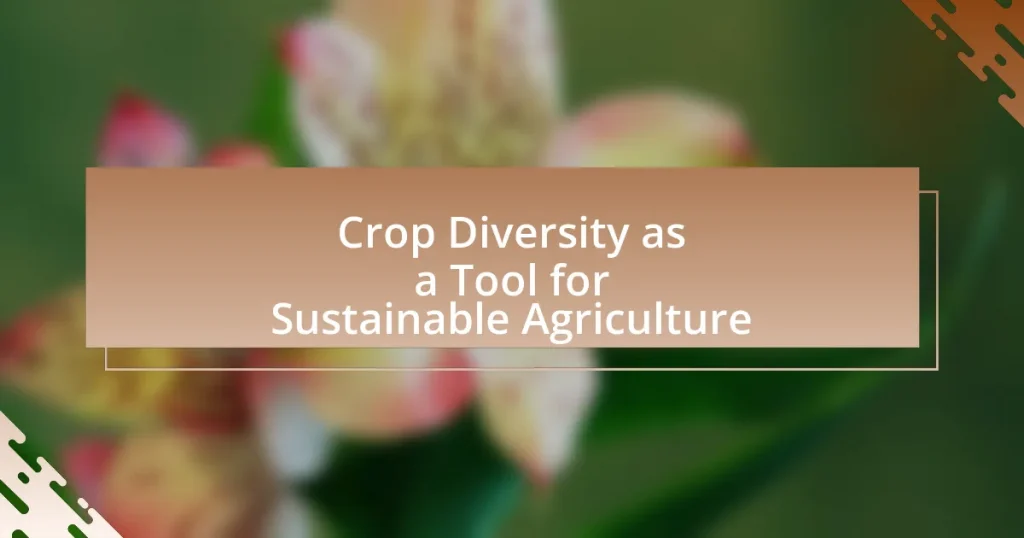Crop diversity is the variety of different crops grown in a specific area, encompassing various species and genetic variations. It plays a crucial role in sustainable agriculture by enhancing ecosystem resilience, improving soil health, and reducing reliance on chemical inputs. The article explores how crop diversity contributes to agricultural sustainability, food security, and economic advantages for farmers, while also addressing the ecological benefits and challenges associated with its implementation. Strategies for promoting crop diversity, including agroecological practices and community initiatives, are discussed, highlighting the importance of education and policy support in fostering diverse cropping systems.

What is Crop Diversity and Why is it Important for Sustainable Agriculture?
Crop diversity refers to the variety of different crops grown in a specific area, encompassing various species and genetic variations within those species. It is important for sustainable agriculture because it enhances ecosystem resilience, improves soil health, and reduces dependency on chemical inputs. Diverse cropping systems can better withstand pests and diseases, as evidenced by studies showing that polycultures can yield up to 20% more than monocultures under certain conditions. Additionally, crop diversity contributes to food security by providing a wider range of nutrients and reducing the risk of crop failure due to climate change or market fluctuations.
How does crop diversity contribute to agricultural sustainability?
Crop diversity significantly contributes to agricultural sustainability by enhancing ecosystem resilience and reducing dependency on chemical inputs. Diverse cropping systems improve soil health, increase biodiversity, and provide habitats for beneficial organisms, which can lead to natural pest control. Research indicates that farms with higher crop diversity can yield more stable production over time, as they are less susceptible to diseases and pests. For instance, a study published in the journal “Nature” found that diverse crop rotations can increase yields by up to 20% compared to monocultures, demonstrating the effectiveness of crop diversity in promoting sustainable agricultural practices.
What are the ecological benefits of maintaining crop diversity?
Maintaining crop diversity provides significant ecological benefits, including enhanced resilience to pests and diseases, improved soil health, and increased biodiversity. Diverse crops can reduce the risk of total crop failure due to specific pests or diseases, as different species may have varying levels of resistance. For instance, studies have shown that polycultures can lead to a 20-50% reduction in pest populations compared to monocultures. Additionally, diverse cropping systems contribute to better soil structure and fertility, as different root systems can improve nutrient cycling and reduce erosion. Furthermore, maintaining a variety of crops supports a wider range of beneficial organisms, such as pollinators and natural pest predators, which are crucial for ecosystem stability.
How does crop diversity enhance resilience against pests and diseases?
Crop diversity enhances resilience against pests and diseases by creating a varied ecosystem that disrupts pest life cycles and reduces the spread of pathogens. When multiple crop species are grown together, they can compete for resources, making it harder for pests to establish and thrive. Additionally, diverse crops can attract beneficial insects that prey on pests, further mitigating damage. Research indicates that polycultures can reduce pest populations by up to 50% compared to monocultures, demonstrating the effectiveness of crop diversity in pest management.
What role does crop diversity play in food security?
Crop diversity plays a crucial role in food security by enhancing resilience against pests, diseases, and climate change. Diverse crops can improve soil health, increase agricultural productivity, and provide a wider range of nutrients, which are essential for a balanced diet. For instance, studies show that farms with higher crop diversity can yield up to 20% more than monoculture systems, as they reduce the risk of total crop failure. Additionally, diverse cropping systems can help stabilize food supplies by ensuring that not all crops are affected by the same environmental stressors, thereby contributing to a more reliable food source for communities.
How can diverse crops improve nutritional outcomes for communities?
Diverse crops can improve nutritional outcomes for communities by providing a wider range of essential nutrients and vitamins. This variety helps to combat malnutrition, as different crops contribute unique nutritional profiles; for instance, legumes are high in protein, while leafy greens are rich in vitamins A and C. Research indicates that agricultural diversity can lead to improved dietary diversity, which is linked to better health outcomes. A study published in the journal “Global Food Security” found that communities with greater crop diversity had significantly higher dietary diversity scores, indicating better overall nutrition. Thus, cultivating a variety of crops not only enhances food security but also promotes healthier diets within communities.
What are the economic advantages of crop diversity for farmers?
Crop diversity provides significant economic advantages for farmers by enhancing resilience against market fluctuations and environmental challenges. By cultivating a variety of crops, farmers can reduce the risk of total crop failure due to pests, diseases, or adverse weather conditions, which in turn stabilizes their income. For instance, a study by the Food and Agriculture Organization (FAO) indicates that diversified farming systems can increase farm income by up to 30% compared to monoculture systems. Additionally, crop diversity allows farmers to tap into niche markets and consumer preferences, leading to higher prices for specialty crops. This adaptability not only improves food security but also promotes sustainable agricultural practices, ultimately benefiting the farmers’ economic stability.

What are the Challenges to Implementing Crop Diversity in Agriculture?
The challenges to implementing crop diversity in agriculture include economic constraints, knowledge gaps, and policy limitations. Economic constraints arise from the initial investment required for diverse seed varieties and the potential for reduced short-term yields, which can deter farmers from adopting diverse cropping systems. Knowledge gaps exist as many farmers lack access to information on the benefits and management of diverse crops, leading to uncertainty in their implementation. Policy limitations often manifest as insufficient support for research and development of diverse cropping systems, as well as inadequate incentives for farmers to shift from monoculture practices. These challenges hinder the widespread adoption of crop diversity, which is essential for enhancing resilience and sustainability in agricultural systems.
What barriers do farmers face in adopting diverse cropping systems?
Farmers face several barriers in adopting diverse cropping systems, including economic constraints, lack of knowledge, and limited access to resources. Economic constraints often arise from the initial investment required for diverse seeds and the potential risk of lower yields during the transition period. A study by the Food and Agriculture Organization (FAO) highlights that many farmers are hesitant to invest in diverse cropping due to uncertainty about market demand and profitability. Additionally, a lack of knowledge about the benefits and management of diverse systems can hinder adoption, as many farmers are accustomed to monoculture practices. Furthermore, limited access to resources such as quality seeds, technical support, and financial services exacerbates these challenges, making it difficult for farmers to implement and sustain diverse cropping systems effectively.
How do market demands influence crop diversity choices?
Market demands significantly influence crop diversity choices by dictating which crops are cultivated based on consumer preferences and economic viability. Farmers and agricultural producers often select crops that align with market trends, such as organic produce or specialty grains, to maximize profits and meet consumer needs. For instance, the increasing demand for gluten-free products has led to a rise in the cultivation of alternative grains like quinoa and millet. This shift not only reflects market preferences but also encourages a broader range of crops, enhancing biodiversity in agricultural systems. Studies indicate that regions responding to market demands can experience increased crop diversity, which contributes to ecological resilience and sustainable farming practices.
What are the impacts of climate change on crop diversity practices?
Climate change negatively impacts crop diversity practices by altering growing conditions, which can lead to reduced genetic diversity and increased vulnerability to pests and diseases. As temperatures rise and precipitation patterns shift, many traditional crop varieties may become less viable, prompting farmers to rely on a narrower range of species that are more resilient to these changes. This reliance on fewer crop types diminishes overall biodiversity, which is crucial for ecosystem stability and resilience. Studies indicate that regions experiencing significant climate variability are seeing a decline in the cultivation of diverse crops, as farmers prioritize short-term yields over long-term sustainability. For instance, research published in “Global Change Biology” highlights that climate-induced stressors have led to a 20% reduction in crop diversity in certain agricultural zones, underscoring the urgent need for adaptive strategies to maintain diverse cropping systems.
How can policy support enhance crop diversity in agriculture?
Policy support can enhance crop diversity in agriculture by providing financial incentives, research funding, and regulatory frameworks that promote the cultivation of a wider variety of crops. For instance, subsidies for farmers who grow diverse crops can encourage them to shift away from monoculture practices, which dominate many agricultural systems. Additionally, government-funded research initiatives can develop and disseminate knowledge on the benefits and techniques of diverse cropping systems, leading to improved resilience against pests and climate change. Evidence from the Food and Agriculture Organization indicates that countries with supportive policies for crop diversity experience increased agricultural productivity and sustainability, demonstrating the effectiveness of such policy measures.
What types of incentives can encourage farmers to diversify crops?
Financial incentives, such as subsidies and grants, can encourage farmers to diversify crops. These financial supports reduce the economic risks associated with transitioning to new crops, making diversification more appealing. For instance, programs like the USDA’s Specialty Crop Block Grant Program provide funding specifically for the cultivation of diverse crops, which has been shown to increase crop variety in participating regions. Additionally, access to technical assistance and education on sustainable practices can further motivate farmers by demonstrating the long-term benefits of crop diversification, such as improved soil health and resilience to climate change.
How can education and resources improve understanding of crop diversity benefits?
Education and resources can significantly enhance understanding of crop diversity benefits by providing farmers and stakeholders with knowledge about the ecological, economic, and nutritional advantages of diverse cropping systems. For instance, educational programs that focus on the role of crop diversity in pest management can demonstrate how varied plant species can reduce pest outbreaks, leading to lower pesticide use and improved soil health. Research from the Food and Agriculture Organization indicates that diverse cropping systems can increase yields by up to 20% compared to monocultures, showcasing the tangible benefits of crop diversity. Additionally, resources such as workshops, online courses, and informational materials can equip individuals with practical skills to implement diverse agricultural practices, thereby fostering a deeper appreciation for the resilience and sustainability that crop diversity offers.

What Strategies Can Be Employed to Promote Crop Diversity?
To promote crop diversity, farmers can implement strategies such as crop rotation, intercropping, and the use of diverse seed varieties. Crop rotation involves alternating different crops in the same field across seasons, which enhances soil health and reduces pest and disease cycles. Intercropping, the practice of growing two or more crops in proximity, can improve resource use efficiency and increase resilience against environmental stressors. Additionally, utilizing a variety of seed types, including heirloom and indigenous varieties, can enhance genetic diversity, making crops more adaptable to changing climate conditions. Research indicates that diverse cropping systems can lead to higher yields and improved ecosystem services, as demonstrated in studies published by the Food and Agriculture Organization, which highlight the benefits of biodiversity in agricultural systems.
How can agroecological practices support crop diversity?
Agroecological practices support crop diversity by promoting the cultivation of a wide range of plant species and varieties, which enhances ecosystem resilience and productivity. These practices, such as intercropping, crop rotation, and the use of cover crops, create a more complex agricultural system that reduces pest and disease pressure while improving soil health. Research indicates that farms employing agroecological methods can increase crop diversity by up to 50%, leading to improved yields and reduced reliance on chemical inputs. This diversification not only contributes to food security but also fosters biodiversity, which is essential for sustainable agricultural systems.
What are the best practices for integrating diverse crops in farming systems?
The best practices for integrating diverse crops in farming systems include crop rotation, intercropping, and the use of cover crops. Crop rotation enhances soil health and reduces pest and disease cycles by alternating different crop families, which can lead to improved yields and reduced reliance on chemical inputs. Intercropping, the practice of growing two or more crops in proximity, can maximize resource use efficiency and improve biodiversity, as evidenced by studies showing increased overall productivity and resilience against pests. Additionally, cover crops protect soil from erosion, improve soil structure, and enhance nutrient cycling, contributing to sustainable agricultural practices. These methods collectively support ecological balance and promote long-term agricultural sustainability.
How can crop rotation and intercropping enhance diversity?
Crop rotation and intercropping enhance diversity by promoting a variety of plant species and improving soil health. Crop rotation involves alternating different crops in the same area across seasons, which helps break pest and disease cycles, reduces soil depletion, and increases biodiversity. Intercropping, the practice of growing two or more crops in proximity, further enhances diversity by maximizing resource use, improving pest management, and fostering beneficial interactions among plants. Research indicates that these practices can lead to increased yields and resilience in agricultural systems, as demonstrated in studies showing that diverse cropping systems can reduce the need for chemical inputs and improve ecosystem services.
What role do community initiatives play in promoting crop diversity?
Community initiatives play a crucial role in promoting crop diversity by fostering local engagement and knowledge sharing among farmers. These initiatives often involve collaborative efforts to cultivate a variety of crops, which enhances genetic diversity and resilience against pests and climate change. For instance, community seed banks, such as those established in various regions, preserve traditional crop varieties and provide farmers access to diverse seeds, thereby encouraging the cultivation of multiple species. Research indicates that regions with active community initiatives report higher levels of crop diversity, which contributes to sustainable agricultural practices and food security.
How can local seed banks contribute to maintaining crop diversity?
Local seed banks contribute to maintaining crop diversity by preserving a wide range of plant genetic resources that are adapted to local conditions. These seed banks collect, store, and distribute seeds from various crop varieties, ensuring that diverse genetic traits are available for future cultivation. For instance, a study by the Food and Agriculture Organization (FAO) highlights that local seed banks can safeguard over 1,000 varieties of a single crop, which enhances resilience against pests, diseases, and climate change. By promoting the use of indigenous and heirloom varieties, local seed banks also support traditional agricultural practices and foster community engagement in sustainable farming.
What are successful case studies of community-led crop diversity projects?
Successful case studies of community-led crop diversity projects include the Svalbard Global Seed Vault in Norway and the Participatory Plant Breeding project in India. The Svalbard Global Seed Vault serves as a global backup for seed diversity, preserving over a million seed samples from around the world, ensuring food security and biodiversity. The Participatory Plant Breeding project in India involves local farmers in the breeding process, allowing them to select and cultivate crop varieties that are best suited to their local conditions, which has led to increased yields and resilience against climate change. These projects demonstrate the effectiveness of community involvement in enhancing crop diversity and promoting sustainable agricultural practices.
What are practical tips for farmers to enhance crop diversity on their farms?
Farmers can enhance crop diversity on their farms by implementing intercropping, which involves growing two or more crops in proximity. This practice not only maximizes land use but also improves soil health and pest management. Research indicates that intercropping can increase yields by up to 20% compared to monoculture systems, as diverse crops can complement each other’s growth and reduce competition for resources. Additionally, farmers should consider crop rotation, which helps break pest and disease cycles while improving soil fertility. Studies show that rotating crops can lead to a 10-30% increase in overall farm productivity. Lastly, incorporating cover crops during off-seasons can enhance soil structure and nutrient content, further supporting diverse cropping systems.










